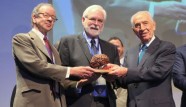$1 M Prize for Brain Research

A brain implant allowing the paralyzed to move robotic limbs by reading brain signals led to the awarding of the $1 million B.R.A.I.N. (Breakthrough Research And Innovation in Neurotechnology) prize to a team of US researchers.
The prize was awarded by President Shimon Peres on behalf of the Israel Brain Technologies organization at the first-ever International Brain Technology Conference in Tel Aviv.
The BrainGate team, led by John Donoghue of Brown University, has developed a system that reads brain signals and transmits them to limbs, enabling patients with degenerative physical diseases to move their arms and hands, and manipulate objects.
Ten international finalists competed for the prize by presenting their work to a panel of judges that included Nobel Prize winners Eric Kandel and Bert Sakmann.
The conference highlighted areas like neurotechnology, which many scientists believe will be an area of strong growth in the coming years, as researchers close in on how to manipulate the brain to treat diseases like depression and Alzheimer’s, and enable brain-machine interfaces and brain-like computing.
President Shimon Peres, who was the inspiration behind the formation of IBT and the B.R.A.I.N. prize, personally presented Donoghue and his BrainGate colleague Dr. Arto Nurmikko with the award.
Israel Brain Technologies, headed by Dr. Rafi Gidron and Miri Polachek, aims to develop Israel as a global hub for brain research.
BrainGate’s technology implants electrodes into the brain to read impulses that are then sent to a computer, which decodes them and allows them to operate a prosthetic or external device. The team has used the technology on numerous patients, including those suffering from “locked-in syndrome” — an inability to move or speak, despite being fully awake and alert and having full mental capacities.
Decades of research (the early technology was originally developed by a now defunct company called CyberKinetics), said Donoghue, showed that groups of neurons work together to allow movement, and the use of sensors to read these neuron signals allowed even patients who were paralyzed and had lost control of their limbs altogether to perform such relatively complicated tasks as using a prosthetic to reach out, grab a cup of coffee and drink it — just by thinking of those actions.

